In early 2020, a health team in the Kayanau region, a community within the Yanomami Indigenous Land, notified the Bolsonaro government that illegal miners had invaded villages, resulting in violence, alcoholism and cocaine use among the indigenous residents. In the report, obtained by SUMAÚMA, the professionals state the criminals took advantage of the indigenous community health center in the region, and used up medicines and vaccines that were in short supply for the Yanomami. The report, which describes the breakdown of a community tormented by mining, was delivered to the Yanomami Special Indigenous Health District, a Ministry of Health entity in the city of Boa Vista.
In February, almost three years after the delivery of the document to the body responsible for Yanomami health, SUMAÚMA heard from indigenous people in the region that the Kayanau community “is finished”. Sexual abuse and prostitution of Yanomami girls, alcohol and drug addiction, and quarrels leading to murder by firearms, brought in by gold miners, have destroyed the region’s villages, where 70 families live. As the document proves, the Bolsonaro government was informed but failed to protect the indigenous people and stop the destruction.
The multidisciplinary team of seven health professionals was in Kayanau between April 18 and May 3, 2020, roughly two years after the first gold miners entered the region. The group’s objective was to bring vaccines and medicines to the community’s health center, which serves five villages: Koremaú, Thothomapi, Torita-Pakirapo-U, Wayahomapi, and Xuimupu-Ú. Located on the banks of the Couto de Magalhães river, a tributary of the Mucajaí river, they are in one of the areas most coveted by illegal miners. The services were also supposed to include Ministry of Health programs, such as healthcare for infants, women and the elderly, screening for sexually transmitted diseases, malaria detection, and monitoring river blindness, a parasitic disease that affects the eyes and has become commonplace in Yanomami territory.
The document, signed by a health professional who will not be identified for security reasons, explains how the work was hampered by the degrading situation found in the community. It recounts how the team went to Torita village, where 14 families live, to administer vaccines: “When we arrived there, drunken indigenous people refused to be vaccinated…the alcohol factor is a huge challenge for any team that operates in the Kayanau area.”
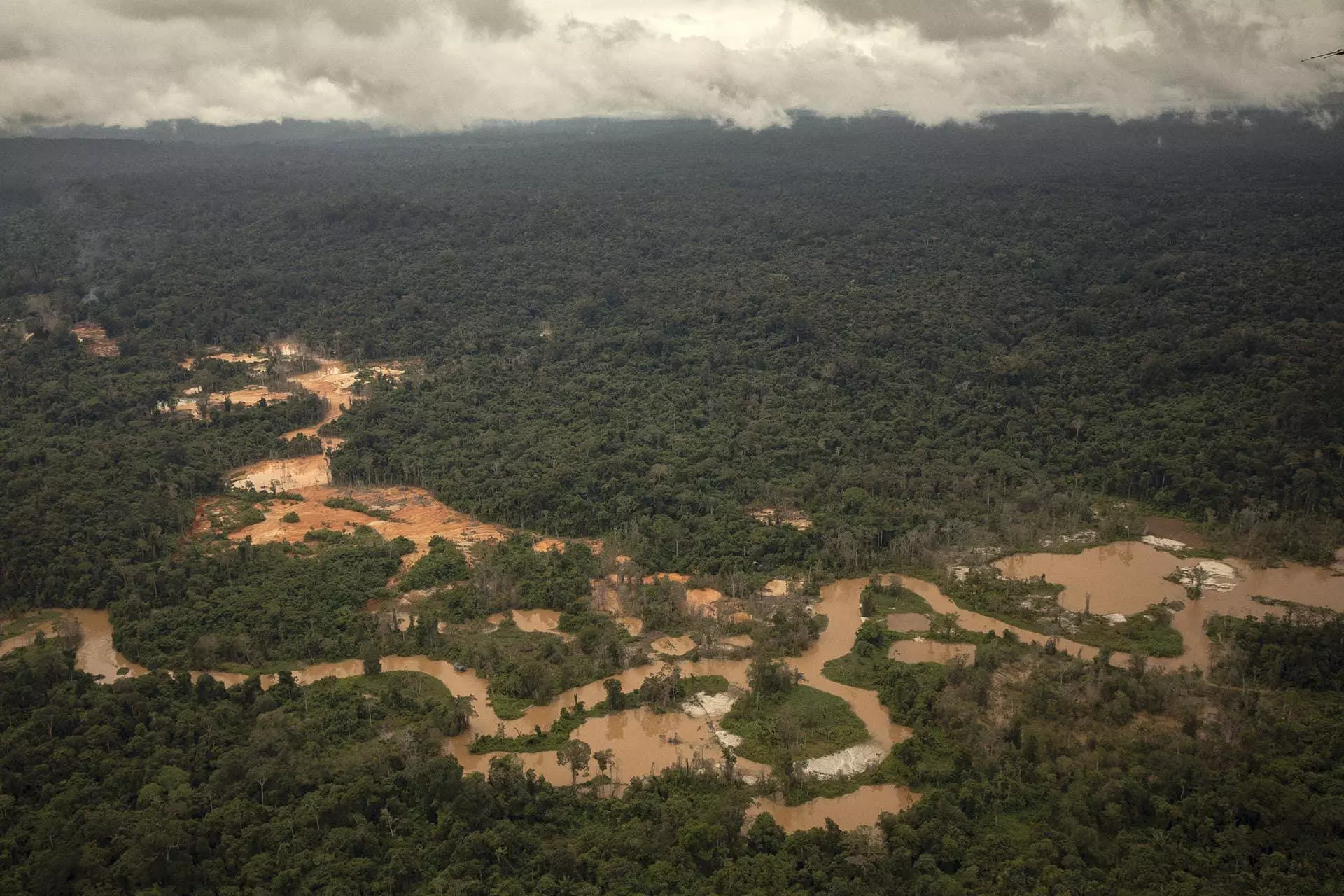
Illegal mining on the banks of the Couto Magalhães river, one of the areas most coveted by the criminals in the Kayanau region. Photo: Bruno Kelly/HAY
The document states that at that time there were 1,600 miners in the Kayanau region: a number more than five times greater than the number of indigenous people in the village (about 310). “What can clearly be seen is interaction between indigenous people and the miners is extremely common. As a result, the living habits, customs/cultures in the community have been modified,” the report notes. “The indigenous people are constantly drunk and walk around carrying alcohol with them the whole time. Signs of this can be seen in every part of the community, including around the health center and on the [airplane] runway, where there are beer cans and cachaça bottles. And, as if this problem were not enough, illicit drugs are being consumed by the indigenous people. Reports from employees as well as from miners indicate indigenous people are using other types of drugs, such as cocaine.” In August, SUMAÚMA was in the Yanomami Territory, and heard from indigenous women in the region that a “white powder” inhaled through the nose is now being consumed by the Yanomami in areas invaded by gold miners.
“As usual, on Sunday, April 26, the Thothomapi community got together, with virtually all the adults drunk. One indigenous man pointed a shotgun at a [health team] employee. Once they start fighting amongst themselves, husbands and wives, brothers and sisters, what would they be capable of doing to the team? This insecurity makes the team feel anxious and vulnerable, because the health team is completely interdependent with the village. When alcohol and drugs take effect, people lose their sense of reality, and they can do irreparable harm.”
The document said the gold miners’ arrival in the region disrupted the way of life of the community, which ceased hunting, fishing and planting vegetable gardens, which were the traditional ways of obtaining food. As a result, the Yanomami in those villages became completely dependent on the criminals. “Mining itself has become a source of income, because a toll is charged for every flight that touches down on the runway. These tolls are spent in the mining camps, on things such as booze, drugs, prostitution, etc.,” the professional declares in the document. “Just to make it clearer, there is a large amount of trade inside this mining camp, where you can find everything you can think of, from common groceries such as rice, beans, pasta, meat, chicken, gas cylinders, oil and salt, to fuels, mechanical parts, internet services, clothing, toiletries and, as mentioned above, bars and sexual services, all at exorbitant prices. Indigenous people from the region told SUMAÚMA that a five-kilogram package of sausage is sold at the Kayanau mining camp canteen for five grams of gold (the equivalent of 1,500 reais). Two kilos of rice and a case of beer cost one gram [300 reais] each.
The report also reveals the Yanomami themselves began to charge the lawbreakers for landing their aircraft on the health center’s airstrip. Each pilot paid 400 reais for each plane that landed to an indigenous woman who was one of the community, with this information being confirmed to SUMAÚMA by two other Yanomami sources. “In a conversation with this leader, when asked if the indigenous people no longer plant, no longer hunt, she simply pointed to an airplane that was on the runway at that moment and said ‘there’s my vegetable garden’.
In other words, why bother to hunt if they can get what they need from the toll they themselves charge. To get an idea of how much money comes into the village, in the first week, from April 18 to 25, more than fifty mining flights landed on the airstrip, money that is spent in the village itself,” explained the professional.
“On a day with not many flights, there might be five planes touching down, and on the day with the most flights there were fourteen. In places where planes can’t be landed, the flights are made by helicopter. I repeat, yes, by helicopter,” the professional says in an astonished tone, since this type of flight is usually a lot more expensive. “The transfer of engines, mining parts and of the gold miners themselves, this could all be observed by the team. Everyone was amazed by the scale of investments that are made [to extract gold and cassiterite].”
The local leader who controlled the landing strip, whose name will be kept confidential, ended up being killed by her own community. SUMAÚMA heard two versions of the crime. According to the first version, she was supposed to have been murdered by her son who was drunk, in a disagreement over money charged for use of the landing strip. According to the other version, she was killed by mistake by another indigenous person who intended to kill her son but whose shot missed the target. When questioned, the Federal Police and the Civil Police did not answer as to whether the crime was reported and investigated, although the death was confirmed to SUMAÚMA by another authority.
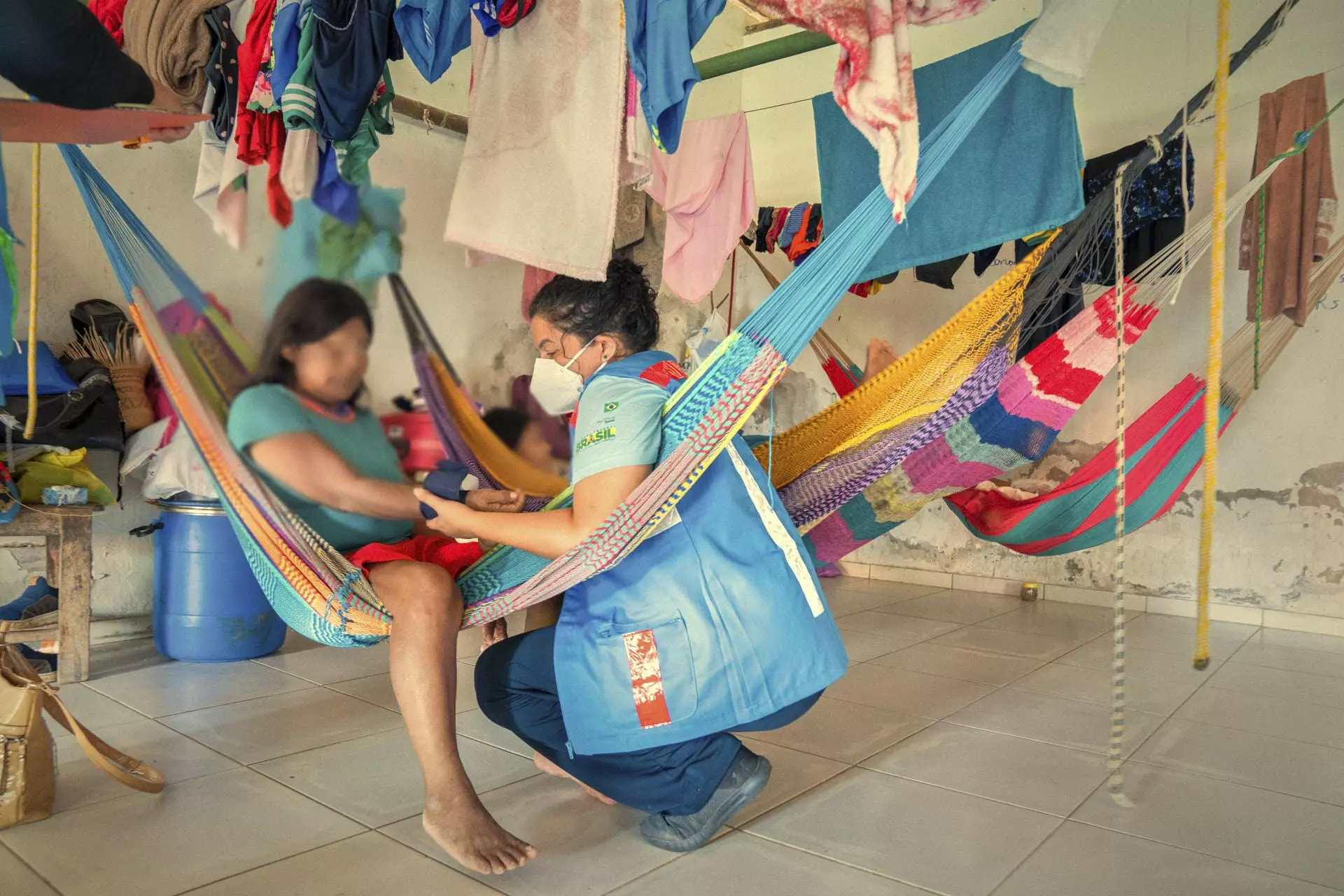
A team from the Yanomami Public Health Emergency Operations Center treats patients at the Indigenous Support House in the city of Boa Vista. Photo: Ministry of Health
The criminals used the health center as if it were their own
The medical team reported the high number of miners in the area used the indigenous health center and related their concern regarding the medicines sent for the treatment of the Yanomami. “During the days that we accompanied the Kayanau village’s routine, it was observed that there was a marked demand from non-indigenous people and, as a result, increased amounts of medicines were handed out, resulting in the depletion of the health center’s supplies.” According to the report, during the mission fifteen indigenous people and thirty miners were treated for river blindness. In two weeks of work, fifty-seven miners and two hundred and fifteen indigenous people were tested for malaria. “Unfortunately, the medications provided by the headquarters [of the Special Indigenous Health District] were not enough to meet the needs. […] In a situation like this, what do you do?”, asked the professional.
He carried on: “In the current situation, [the miners] will continue to seek care, whether for malaria or for any other reason, since the only health reference is the Kayanau community health center. My suggestion would be for them to rethink the supply issue so that the indigenous people are not negatively affected as [was the case] in [epidemiological] week 18, due to a lack of primaquine 5 [mg] and 15 [mg, medicines used for the treatment of malaria].” Epidemiological week is a universal time classification for health statistics. In 2020, week 18 occurred between April 26 and May 2.
The report pointed out how gold miners were responsible for the increase in malaria cases among indigenous people. “It can be noticed that the main concentration of malaria is among [the gold miners]. In conversation with a female miner, she reported that there are breeding grounds there. She admitted that among the miners who are there, it is rare to find one who has not caught malaria at least once and this is where indigenous people get infected.” The team also recommended actions to deal with the large pools of water where malaria-transmitting mosquitoes multiply.
In 2020, the year in which the team was on site, the Kayanau health center registered 584 locally-contracted cases of malaria: 217 of them among children up to the age of 9 years old. The public data was obtained by SUMAÚMA via the Access to Information Law. In 2018, the first year in which the miners arrived, there were 151 cases. Thus, between 2018 and 2020, there was an almost fourfold increase. The high incidence of malaria caused a disaster in the village when Covid-19 arrived on the scene, affecting bodies that had already been weakened. A statement taken in July 2020, which SUMAÚMA had access to, illustrates the tragedy.
“This serious disease [Covid-19] is very strong there in Kayanau, because the miners always land there in planes. So, they brought this serious disease to Kayanau. And after the miners brought it [Covid-19] in, this awful thing happened to my sister. That’s how it happened. When it was just us, we didn’t get sick like this,” a woman from the region explained at the time. “Before, I thought she had malaria. I thought that before, but now the tracks of the heart-eater, lung-eater appeared. So that was the trail left behind by that disease [Covid-19].” She described how she lost a sister to the disease, whose body, at the time of the interview, was “suspended” in the forest, in reference to a part of the Yanomami funeral ritual. The woman reported that a health center employee sold medicines and serums sent for the treatment of the indigenous people to the miners.
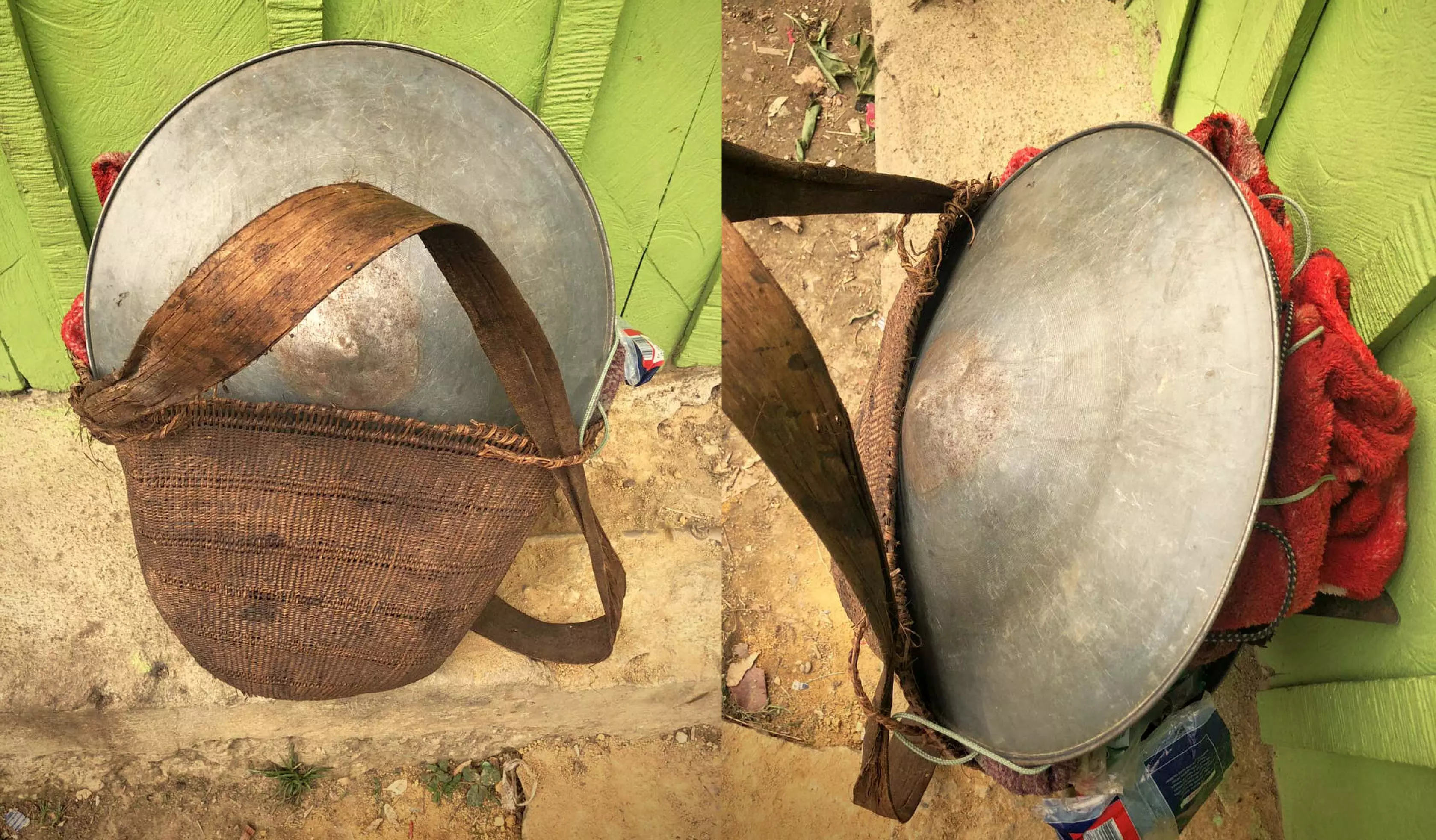
Gold panning instrument in the basket of an indigenous woman recruited into gold mining in Kayanau. A report on the community’s destruction was delivered to Bolsonaro’s government in 2020, but it failed to act
The health team had to use contaminated water
The report made by the medical task force that was in Kayanau in 2020 also stated that the health post had a high turnover of nurses, which made it harder to deliver a “quality service” as well as to produce “reliable data regarding health actions”. This information adds to suspicions that the Yanomami area came under a partial statistical blackout. This yet another indication that the number of children who died due to a lack of adequate medical care over the past four years may be even higher than the 570 that SUMAÚMA revealed in January.
The heath center’s structure was listed as being one of the main reasons for the high turnover: “One of the major problems faced at the clinic was the fact there is no water to supply the dorms, with water from the river being used for everything, for consumption and for sanitation, since the water from the river is muddy and polluted, as well as being used by the miners for extracting [gold] with their machines and for washing themselves. When it rains you can store it, but not always. The team is using a makeshift bathroom, because the one in the health center is out of order.
The professional stressed that up until that time relations had been good between the health team and the gold miners, since the criminals used the health clinic on a regular basis. However, the situation changed in March 2022. The health center was closed down due to “threats to the employees,” according to the Ministry of Health. At present, the indigenous people in the region are without any regular medical care. The Ministry of Health’s task force, which arrived in Yanomami territory on January 16 this year in order to try and stem the health breakdown, has not yet managed to reach Kayanau, as the medical team’s safety cannot yet be guaranteed.
The Special Indigenous Health District’s coordinator at the time the report was made was Francisco Dias Nascimento Filho, a major in the army. According to the local press he is linked to Senator Mecias de Jesus (of the Republicans Party), one of the members of the commission set up by the senate to monitor the Yanomami’s situation. Our reporter was unable to reach Major Nascimento Filho. In a statement, the current administration of the Ministry of Health’s Indigenous Health Department Secretariat stated it will investigate the context of the report with the local Special Indigenous Health District.
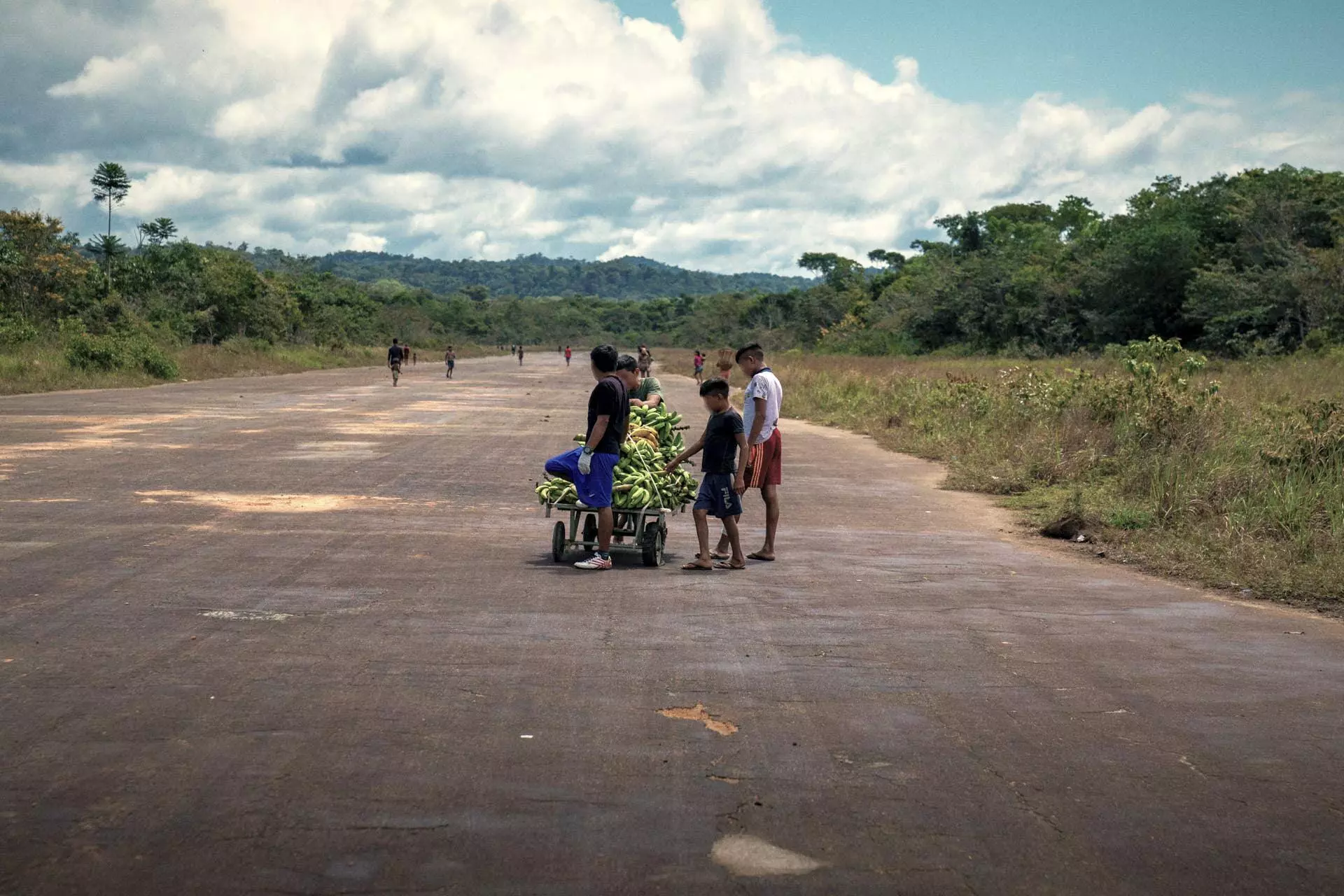
Delivery of food to Yanomami people on February 12, 2023. Photo: Wanderson Contijo/Ministry of Health
From burnt skirts to sexual violence
With a subsoil rich in minerals, Kayanau is a community that has been historically threatened by illegal mining. During the first major mining invasion in the Yanomami Indigenous Land in the 1980s, it was in this region that one of the chief mining structures operated. Back then, the families that belonged to the Kayanau community lived in a village called Papiú, the center of the criminal invasion. According to data from the Socio-environmental Institute, it is estimated that 15,000 miners worked in that area alone. Prior to the invasion, 400 Yanomami lived there, but their numbers declined to 250 in 1990: 37% of the population died or fled on account of the illegal mining.
In the wake of the demarcation of the Yanomami Indigenous Land in 1992, the miners were removed from the area and the health situation in Papiú stabilized. To celebrate this new moment, the community’s women burned all the skirts on a bonfire they had been wearing since contact with white people. In some cases, the clothing had been received in exchange for sex and had become a symbol of the harm that contact had done to that indigenous people.
At the end of the 1990s, part of the Papiú group migrated down the Couto de Magalhães River, establishing the region known as Kayanau. In the 2000s, the community, hopeful about its future, began to fight for the expansion of the school in the area. “Why do we want the school?”, asked a document signed by three local leaders sent to the government on March 6, 2009. “We want to learn; we don’t want to lose our culture. We want to learn Portuguese so we won’t be supervised anymore. We want to study to become Indigenous Health Agents and get rid of the xawara (disease, epidemic). For this reason, we want school. We also want to fight for our land, and we also want the children to grow up and continue to speak our language. We don’t want to lose this”, explained the community’s teachers Antonio Tihiri, Jóse Arari and Sarnei Hayari. There was a small school in the community, school supplies and, in 2009, twenty-five students were attending elementary school and twenty-one were taking the youth and adult education programs. Nowadays, according to the State of Roraima’s government, just twenty people are studying at this school. Many of the young people from Kayanau were recruited by the miners.
Translated by Mark Murray
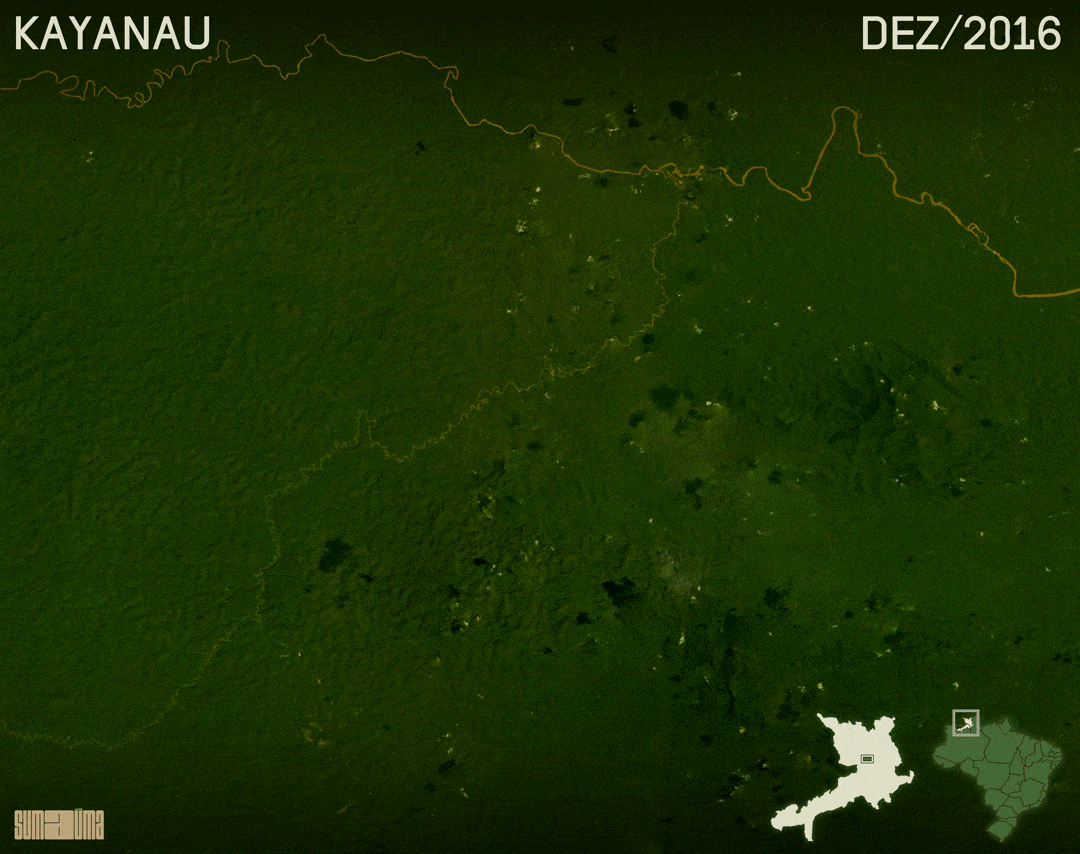
Satellite images show how deforestation caused by illegal mining has increased in the Kayanau region on the banks of the Couto de Magalhaes River, formerly used by indigenous people for fishing, collecting water or bathing.
Source: Monitoring System of Illegal Mining on Yanomami Indigenous Land, conducted by the Hutukara Yanomami Association with technical assistance from the Socioenvironmental Institute.





